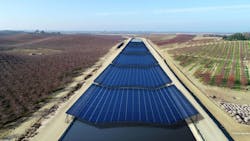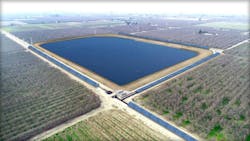California Fights Drought and Climate Change with Solar-Shaded Canals
By using miles-long solar arrays as shades to protect part of California's extensive canal system against evaporative losses, Project Nexus will explore a novel way to cope with long-term drought conditions while helping halt the climate change that caused them.
The $20 million pilot project, currently underway in California's Turlock Irrigation District (TID), will construct shade canopies composed of solar panels over various sections of the district's canal system. It will serve as a proof of concept for larger projects while providing important information about designing and deploying solar-over-canal systems, as well as the co-benefits of combined water conservation and grid-scale solar systems.
The project will break ground in mid-October at two locations:
- A 500-foot span of a canal in Hickman, east of Modesto
- A mile-long canal span in the nearby city of Ceres
With an anticipated completion date of late 2023, Project Nexus will be used to demonstrate the feasibility of using narrow and wide-span canal coverage of solar panels for combined water conservation and grid-scale renewable power generation.
Once in operation, TID will collect detailed data on how well the solar canopies reduce water evaporation as the result of midday shade and wind mitigation; how they create improvements to water quality through reduced vegetative growth; and reduce canal maintenance as a result of reduced vegetative growth. The study also will explore the system's reliability and maintenance requirements, as well as the challenges involved with integrating them with the state's electrical distribution and storage grid.
Roger Bales, distinguished professor of engineering at the University of California, Merced, who is working on this project, wrote in the Conversation:
"Most of California’s rain and snow falls north of Sacramento during the winter, while 80% of its water use occurs in Southern California, mostly in summer. That’s why canals snake across the state—it’s the largest such system in the world. We estimate that about 1-2% of the water they carry is lost to evaporation under the hot California sun.
In a 2021 study, we showed that covering all 4,000 miles of California’s canals with solar panels would save more than 65 billion gallons of water annually by reducing evaporation. That’s enough to irrigate 50,000 acres of farmland or meet the residential water needs of more than 2 million people. By concentrating solar installations on land that is already being used, instead of building them on undeveloped land, this approach would help California meet its sustainable management goals for both water and land resources."
Covering most of California’s 4000 miles of canals in solar panels also would create a distributed solar generating system with a peak capacity of 13 gigawatts. That’s enough to power 9.75 million of California's estimated 13.1 million households (based on a study conducted July 2021) during daylight hours.
This is about one-sixth of the state’s current installed capacity, or half the projected new capacity needed to meet the state’s 2030 decarbonization goals. The added renewable capacity also will help the state support its commitment to ban the sale of gasoline-powered vehicles by 2035 and its goal of requiring medium- and heavy-duty trucks to be zero emissions by 2045 "where feasible."
Additional information can be found at the Project Nexus website as well as the following articles:
Nature: “Energy and water co-benefits from covering canals with solar panels”
Electrek: “In a US first, California will pilot solar-panel canopies over canals” and “Solar panels and California’s canals could make a winning pair”
Fruit Growers News: "Reducing evaporative water loss, other aims projected with California solar panels”
About the Author
Lee Goldberg
Contributing Editor
Lee Goldberg is a self-identified “Recovering Engineer,” Maker/Hacker, Green-Tech Maven, Aviator, Gadfly, and Geek Dad. He spent the first 18 years of his career helping design microprocessors, embedded systems, renewable energy applications, and the occasional interplanetary spacecraft. After trading his ‘scope and soldering iron for a keyboard and a second career as a tech journalist, he’s spent the next two decades at several print and online engineering publications.
Lee’s current focus is power electronics, especially the technologies involved with energy efficiency, energy management, and renewable energy. This dovetails with his coverage of sustainable technologies and various environmental and social issues within the engineering community that he began in 1996. Lee also covers 3D printers, open-source hardware, and other Maker/Hacker technologies.
Lee holds a BSEE in Electrical Engineering from Thomas Edison College, and participated in a colloquium on technology, society, and the environment at Goddard College’s Institute for Social Ecology. His book, “Green Electronics/Green Bottom Line - A Commonsense Guide To Environmentally Responsible Engineering and Management,” was published by Newnes Press.
Lee, his wife Catherine, and his daughter Anwyn currently reside in the outskirts of Princeton N.J., where they masquerade as a typical suburban family.
Lee also writes the regular PowerBites series.




